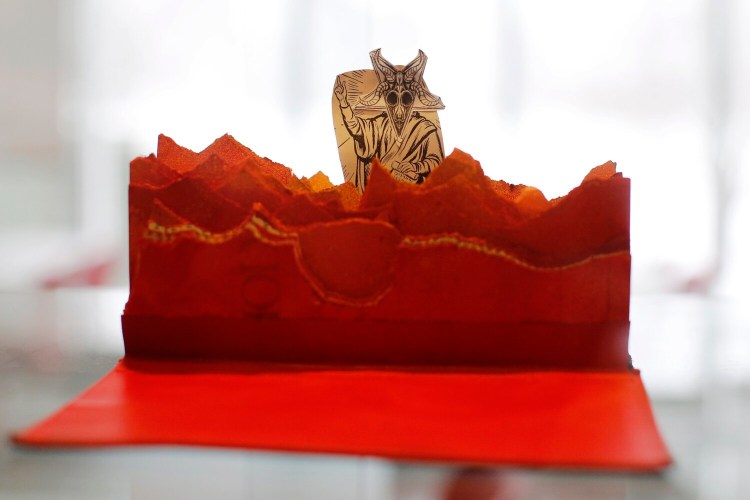A defaced Bible in a display of student artwork at the University of Southern Maine has sparked a complaint from a member of a church that meets in the building where the work is exhibited.
The piece by USM student Riley Harris features a Bible with torn pages painted to look like flames and Satanic images covering the face of Christ.
“This is someone’s sacred text being desecrated, destroyed and displayed in a public place,” said Charlie Flynn, whose young daughter noticed the piece on display outside a classroom when they were at a church gathering recently at the Wishcamper Center on the Portland campus.
The Casco Bay Church of Christ is among several community groups that rent space at the university and meet there regularly.
“I couldn’t help but feel no one’s sacred text should be treated that way,” Flynn said. “I think it’s very inappropriate and repugnant.”
Harris said he created his piece – called “Unholy Bible: Very Revised Standard Edition” – to fulfill an assignment for an art class in which students were assigned to re-purpose a book into something new.
“I was thinking a lot about questioning authority in general,” said Harris, a sophomore studying art and entrepreneurship. “People question different types of authority, but for some reason religious authority seems too taboo to question, so I thought I would give it a shot.”
Jared Cash, vice president for enrollment management and marketing at the university, defended the piece Monday, saying in a statement, “The university supports freedom of speech rights for all students, affirmed and upheld by Board of Trustee System Policy 212.”
The policy states that the university supports free speech so long as it does not “violate the law, defame specific individuals, genuinely threaten or harass others, or violate privacy or confidentiality requirements or interests.”

Riley Harris poses Tuesday outside the Wishcamper Center on USM’s Portland campus. Harris, a sophomore at USM, is the artist who created “Unholy Bible: Very Revised Standard Edition” which is on display in the Wishcamper Center. He said, “For some reason religious authority seems too taboo to question, so I thought I would give it a shot.” Brianna Soukup/Staff Photographer
“Although the University System greatly values civility and expects community members to share in the responsibility for maintaining a climate of mutual respect, demands for civility and mutual respect will not be used to justify restricting the discussion or expression of ideas or speech that may be disagreeable or even offensive to some members of the University community,” the policy states.
This is not the first time the university has encountered controversy around works of art. In 2018, USM President Glenn Cummings defended a decision to remove three oil paintings by Bruce Habowski, a convicted sex offender, on display on the Lewiston-Auburn campus.
Cummings said at the time the works could “serve as a trigger” for victims of abuse, though critics said the university was unfairly censoring an artist who had paid his debt to society for a conviction that was almost 20 years old.
Flynn said that while he understands the right to freedom of speech, he felt the piece by Harris was hateful.
“If I saw a Koran with pig blood on it I would certainly call someone, or a Torah with unclean foods on it,” he said. “This is a Bible with Satan’s image put over Jesus’ image and around Christmastime. I don’t understand why that would be viewable in an institution of higher learning. This is USM, a school that services the community.”
Glenn Petruzzi, minister for the church, also noticed the piece and was saddened by it.
Overall, he said the church has a great relationship with the university and always has felt welcome. However, he said more thought should have been put into considering whether the piece should be on display.
“Freedom of speech is entitled, but when that space is shared with all different types of people of different faiths and backgrounds we have to consider what that will bring about,” Petruzzi said. “It’s a hard one.”
Harris said the assignment for the class, “The Introduction to the Visual Book,” taught by Rebecca Goodale, was to alter a book to create something new.
He said when the assignment was presented, Goodale mentioned that altering a book could be seen as an act of plagiarism, so he decided to pick a book in the “public domain” to be safe.
Goodale, a lecturer at the university, did not respond to a phone message left at her office or an email sent Monday.
Harris also said part of his intent was to question authority. While the Bible and Christianity are “important to some people, a lot of Christianity harms other people,” he said.
Harris, who considers himself an atheist, said he did get push-back from some of his classmates while working on the assignment last semester, but has not received much feedback since finishing the piece.
“I get that (negative reaction),” Harris said. “My only reaction to people responding to it negatively is everyone has their own sort of morals and no one’s morals are right or really wrong. Everyone thinks their own way – and not everyone’s (morals) line up.”
He added, “I don’t think my piece is harming anyone. It’s just making people think. I think when it starts harming someone then maybe it should be considered not great.”
Meanwhile, Flynn apologized to Harris for any pain the church has caused him or others. He said he called the university to express concern about the piece and was told it would be looked into.
“I think it’s worth having a conversation around what do we in our community and institutions value,” Flynn said. “I think everyone’s sacred texts are valuable.”
Comments are not available on this story.
Send questions/comments to the editors.



